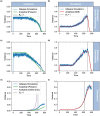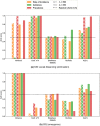Prospects for detecting early warning signals in discrete event sequence data: Application to epidemiological incidence data
- PMID: 32960900
- PMCID: PMC7531856
- DOI: 10.1371/journal.pcbi.1007836
Prospects for detecting early warning signals in discrete event sequence data: Application to epidemiological incidence data
Abstract
Early warning signals (EWS) identify systems approaching a critical transition, where the system undergoes a sudden change in state. For example, monitoring changes in variance or autocorrelation offers a computationally inexpensive method which can be used in real-time to assess when an infectious disease transitions to elimination. EWS have a promising potential to not only be used to monitor infectious diseases, but also to inform control policies to aid disease elimination. Previously, potential EWS have been identified for prevalence data, however the prevalence of a disease is often not known directly. In this work we identify EWS for incidence data, the standard data type collected by the Centers for Disease Control and Prevention (CDC) or World Health Organization (WHO). We show, through several examples, that EWS calculated on simulated incidence time series data exhibit vastly different behaviours to those previously studied on prevalence data. In particular, the variance displays a decreasing trend on the approach to disease elimination, contrary to that expected from critical slowing down theory; this could lead to unreliable indicators of elimination when calculated on real-world data. We derive analytical predictions which can be generalised for many epidemiological systems, and we support our theory with simulated studies of disease incidence. Additionally, we explore EWS calculated on the rate of incidence over time, a property which can be extracted directly from incidence data. We find that although incidence might not exhibit typical critical slowing down properties before a critical transition, the rate of incidence does, presenting a promising new data type for the application of statistical indicators.
Conflict of interest statement
The authors have declared that no competing interests exist.
Figures



Similar articles
-
Early warning signals of infectious disease transitions: a review.J R Soc Interface. 2021 Sep;18(182):20210555. doi: 10.1098/rsif.2021.0555. Epub 2021 Sep 29. J R Soc Interface. 2021. PMID: 34583561 Free PMC article. Review.
-
Detecting critical slowing down in high-dimensional epidemiological systems.PLoS Comput Biol. 2020 Mar 9;16(3):e1007679. doi: 10.1371/journal.pcbi.1007679. eCollection 2020 Mar. PLoS Comput Biol. 2020. PMID: 32150536 Free PMC article.
-
Spatial early warning signals of social and epidemiological tipping points in a coupled behaviour-disease network.Sci Rep. 2020 May 6;10(1):7611. doi: 10.1038/s41598-020-63849-0. Sci Rep. 2020. PMID: 32376908 Free PMC article.
-
Anticipating infectious disease re-emergence and elimination: a test of early warning signals using empirically based models.J R Soc Interface. 2022 Aug;19(193):20220123. doi: 10.1098/rsif.2022.0123. Epub 2022 Aug 3. J R Soc Interface. 2022. PMID: 35919978 Free PMC article.
-
Effectiveness of Public Health Digital Surveillance Systems for Infectious Disease Prevention and Control at Mass Gatherings: Systematic Review.J Med Internet Res. 2023 May 19;25:e44649. doi: 10.2196/44649. J Med Internet Res. 2023. PMID: 37204833 Free PMC article.
Cited by
-
A joint Bayesian spatiotemporal risk prediction model of COVID-19 incidence, IC admission, and death with application to Sweden.Ann Reg Sci. 2022 Nov 28:1-34. doi: 10.1007/s00168-022-01191-1. Online ahead of print. Ann Reg Sci. 2022. PMID: 36465998 Free PMC article.
-
Early warning signals of infectious disease transitions: a review.J R Soc Interface. 2021 Sep;18(182):20210555. doi: 10.1098/rsif.2021.0555. Epub 2021 Sep 29. J R Soc Interface. 2021. PMID: 34583561 Free PMC article. Review.
-
Performance of early warning signals for disease re-emergence: A case study on COVID-19 data.PLoS Comput Biol. 2022 Mar 30;18(3):e1009958. doi: 10.1371/journal.pcbi.1009958. eCollection 2022 Mar. PLoS Comput Biol. 2022. PMID: 35353809 Free PMC article.
-
Estimating the basic reproduction number from noisy daily data.J Theor Biol. 2022 Sep 21;549:111210. doi: 10.1016/j.jtbi.2022.111210. Epub 2022 Jul 3. J Theor Biol. 2022. PMID: 35788342 Free PMC article.
-
Early warning signal reliability varies with COVID-19 waves.Biol Lett. 2021 Dec;17(12):20210487. doi: 10.1098/rsbl.2021.0487. Epub 2021 Dec 8. Biol Lett. 2021. PMID: 34875183 Free PMC article.
References
-
- Holloway B, Goodman R. Recommendations of the international task force for disease eradication. Morbidity and mortality weekly report. 42(16):1–38. 1993. - PubMed
Publication types
MeSH terms
Grants and funding
LinkOut - more resources
Full Text Sources
Medical

